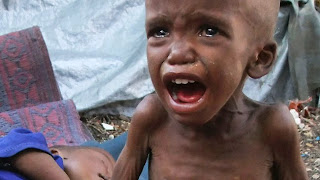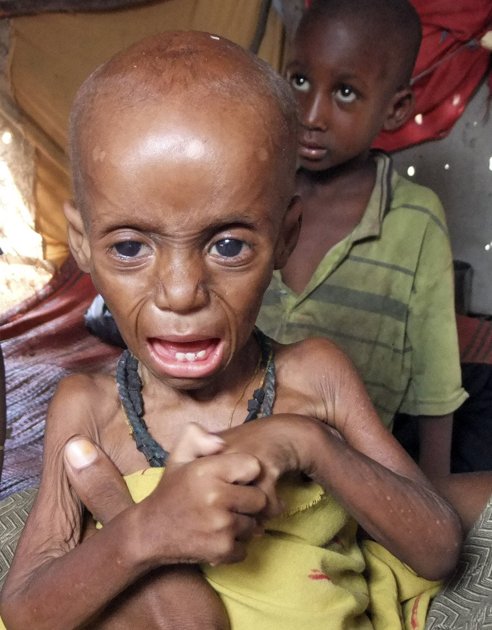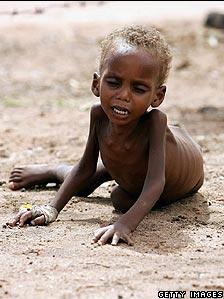Facts
Somalia has existed in a security vacuum since 1991. Since then, fighting between rival warlords and an inability to deal with famine and disease has led the UN and numerous other organizations to describe the humanitarian situation in Somalia as the worst in Africa and the world.
Reports indicate that 3.2 million Somalis, about 45% of the entire population, are suffering from hunger and malnutrition and are in dire need of emergency humanitarian assistance. Of the 3.2 million, 650,000 children are under the age of five.
In addition to the humanitarian crisis in Somalia, there are over a quarter million Somali refugees in Kenya alone. These refugees are living in vercrowded and inadequate conditions. Despite these crises, news media are not covering these crises and there is a global silence on this staggering suffering.
Humanitarian and Refugee Fact Sheet
Overwhelming focus on recent piracy in Somalia has undermined the staggering humanitarian and refugee crisis in Somalia, the world’s worst humanitarian crisis according to the United Nations High Commission for Refugees.
The U.S. Ambassador to Kenya, Michael E. Ranneberger, and a number of international agencies have declared Somalia a major humanitarian crisis with a complex emergency caused by drought, high food prices, rising malnutrition rates, disease outbreaks, population displacement, and civil insecurity, to mention a few.
The United States Agency of International Development’s June 1, 2009 report shows that:
3.2 million Somalis, about 45% of the entire population, are suffering from hunger and malnutrition and are in dire need of emergency humanitarian assistance.
Of the 3.2 million suffering Somalis, 650,000 are children under the age of five.
Over 8% of the population is suffering from acute malnutrition, that is more than the 1% of the global threshold for emergency food crisis.
Health problems associated with acute malnutrition include marasmus (wasting of fat, muscle and other tissues); cretinism causing limited mental and physical growths; brain damage; blindness; infection; and death particularly among children under five years old and adults with health problems.
Yet, there is a global silence on this staggering human suffering.
The Plight of Somali Refugees
Over a quarter million Somali refugees in Kenya are living in overcrowded and inadequate refugee camps developed for 90,000 refugees.
Gerry Simpson of Human Rights Watch and Refugee Researcher concluded on his recent visit to refugee camps, "The refugee crisis worsens with every day of delay and continued paralysis and unresponsiveness puts the well-being of all the refugees — new and old — at grave risk".
Kenya, Ethiopia, Yemen, Nepal, and Turkey should respect the United Nations Convention on the Status of Refugees and Protocol relating to the Status of Refugees and end their mistreatment and unlawful arrest of Somali refugees.
How You Can Help Alleviate the Crisis?
Take just one minute to call your Senators and Representatives at (202) 224-3121. Provide your zip code to the operator who will connect you with the office of your legislator. Share with them the following key messages or make your own unique message:
Sponsor or support increased emergency food aid assistance in Somalia.
Sponsor or support the development of a plan to provide protection and assistance to refugees in Kenya and Yemen, and internally displaced people in Somalia.
Sponsor or support the development of a comprehensive strategy that deals with the full range of humanitarian and refugee crisis facing Somalia.
Somalia Famine Could Claim 750,000 Lives in Next Four Months Without Better Aid
The worst drought in East Africa in 60 years continues to take a severe toll. The tragic stats coming from the UN (via BBC News):
Six areas are now considered to be afflicted by famine, with the latest, the Bay region, being worse than any so far--58% of children there are malnourished, a record rate of acute malnutrition. 12 million people in East Africa, 4 million people in Somalia alone, are affected.
750,000 of these people in Somalia being "at risk of death in the coming four months in the absence of adequate response", according to the UN's Food Security and Nutritional Analysis Unit.
The Dadaab refugee camp in Kenya is now that largest in the world, with as many people in it as Kansas City, Missouri.
Overall it's worse than the famine in Somalia in 1992 and is approaching equaling the Ethiopian famine in the mid-1980s.
Read the BBC article linked above for some background on the famine, the role of Islamic militants in preventing aid from reaching affected areas (for a while at least they denied famine existed) and preventing Somalis from leaving the nation, such as it can be called a nation.
As for the absence of adequate response to the ongoing natural and humanitarian disaster, Mother Jones makes the case that the de facto media blackout of the famine certainly isn't helping the situation.
The article cites data from the Pew Research Center showing that over July and August the East African famine has accounted for just 0.7% of all news coverage. And cites Doctors Without Borders figures on how a little bit of coverage can go a long way--when ABC briefly covered the famine the aid organization reports that it received more than $100,000 in donations in one night.
As for the role of climate in this, UNEP head Achim Steiner reminds us that all signs pointing to climate change "exponentially" increasing the scale of of natural disasters.
And a quick glance at a map of the areas of the world with the greatest food security risk and one showing greatest water stress due to climate change and population growth shows where the impact will most acutely be felt:
29,000 Children Dead Due to East African Famine in Past Three Months (Video)
http://www.treehugger.com/files/2011/08/29000-children-dead-east-african-famine-past-three-months.php
http://somalipeacemaker.blogspot.com/2011/09/new-images-of-famine-stricken-somalia.html
U.N.: 750,000 people in Somalia face 'imminent starvation'
http://edition.cnn.com/2011/WORLD/africa/09/05/somalia.famine.report/index.html
=====
Somalia Famine: UN Needs More Money to Increase Aid
The fate of tens of thousands of people living and dying from famine in the Somalia is literally in the hands and hearts of the internationally community.
The deadly famine in Somalia could spread if the international community doesn't provide the funds needed to respond to the hunger crisis that has already killed thousands, the United Nations humanitarian chief warned.
"Unless we see a massive increase in response, the famine will spread to five or six more regions," Valerie Amos, the Under-Secretary-General for Humanitarian Affairs, told reporters at U.N. Headquarters. "Tens of thousand(s) of Somalis have already died and hundreds of thousands face starvation."
The U.N. humanitarian agencies declared famine in two areas of southern Somalia last month.
Amos said the drought in the Horn of Africa is the worst in 60 years, according to information on the U.N.'s Web site.
The drought had already affected large areas of Kenya, Ethiopia and Djibouti and has left an estimated 12.4 million people in need of humanitarian aid, according to the U.N.
Amos, who is also the U.N. Emergency Relief Coordinator, said early warning systems had predicted the drought last year and humanitarian agencies had appealed for $1.6 billion dollars.
"As of mid-year, around half of that money had been raised, and as of last week donors had committed more than $1 billion," Amos said in a statement. "It is not enough. But neither was the crisis ignored as some have suggested. And even as we ask ourselves some important questions we can't allow those to distract from the task at hand. We need to deal with the here and now as well as with the longer term."
Amos said $1.4 billion is needed immediately so that relief organizations can ramp up response to the hunger crisis in the region.
She also urged traditional donors who have already contributed generously, to provide additional resources. Amos is also appealing to corporations, foundations and private individuals to provide some help as well.
Longer-term measures to make drought-prone areas of the Horn of Africa more resilient are already being implemented, according to Amos. She cited Ethiopia's social welfare scheme known as the Productive Safety Nets Program, and Kenya's employment plan that promotes natural resource management in arid and semi-arid areas.
Amos also asked that parties involved in Somalia's conflict uphold international humanitarian law so that aid workers can deliver help to those in need.
The U.N. will support a plan by the African Union to hold a funding conference for the Horn of African hunger crisis later this month, Amos said.
http://www.ibtimes.com/articles/190880/20110802/somalia-famine-un-needs-more-money-to-increase-aid.htm
http://www.life.com/gallery/62981/image/119370229/famine-in-somalia#index/0
http://lightbox.time.com/2011/08/25/collateral-crisis-the-catastrophic-famine-in-somalia/#18
http://thewe.cc/weplanet/news/children/hunger_children_dying.htm
HELP: UN seeks more donor help on Somalia famine
http://www.unicef.org.uk/landing-pages/hornofafricaweb/
http://www.unhcr.org/emergency/somalia/global_landing.html?gclid=CJyA7M_GrqsCFUp76wod2mDlKA
http://www.icrc.org/eng/donations/index.jsp
http://www.civicworldwide.org/healing-the-wounds/somalia
United Nation High commission for Refugees (UNHCR)
http://www.unhcr.org/emergency/somalia/global_landing.html?gclid=CJyA7M_GrqsCFUp76wod2mDlKA
Help Save Lives in Drought-Stricken East Africa
https://wfp.org/donate/hornofafrica?gclid=CO7DxLf9sKsCFUF76wodxBOrfQ
International Committee of the Red Cross (ICRC)
http://www.icrc.org/eng/donations/index.jsp
http://www.globalgiving.co.uk/pr/8500/proj8493a.html?rf=ggadgguk_goog_even_somalia_4&gclid=CO3xu8zKr6sCFQUb6wodO2hueQ
Somalia's Children Caught in the Crossfire
https://takeaction.amnestyusa.org/site/c.6oJCLQPAJiJUG/b.6662481/k.2BA2/Donate_Now/apps/ka/sd/donorcustom.asp?msource=W1108EDCRYJ&tr=y&auid=8824967
http://www.unmultimedia.org/photo/gallery.jsp?query=subject:%22Famine+in+Somalia%22
http://www.wfp.org/stories/horn-africa-10-ways-you-can-help
https://www.wfp.org/donate/fillthecup
https://www.secure.careinternational.org.uk/form.asp?id=697&cachefixer=
https://secure.unicefusa.org/site/Donation2?df_id=10380&10380.donation=form1&JServSessionIdr004=rwf5jmp7sc.app227a
http://www.freerice.com/#/english-vocabulary/1411



































































































